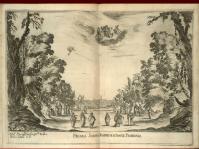The importance of context
Such checks notwithstanding, festivals were significant contributions to political debate and, to understand their meaning fully, each Festival book needs to be set within its immediate context. At Toulouse in 1565, for example, Charles IX’s entry was marked by an emphasis on local history, with the inventor of the arches going back to old volumes of annals (and to Plutarch and Strabo). New dynasties sought to reinforce their claims to legitimacy, as in Emperor Ferdinand I’s entry into Prague in 1558, or that of Sigismund III into Cracow thirty years later. The marriage celebrations of the Elector Palatine in 1613 were the culmination of years of political manoeuvering and gatherings among Protestant princes who had wished, in their festivals, to make visual statements about war and peace and national identity, as well as expressing their hopes for unity. The tour of Northern Italian cities by Henri III on his return to France from Cracow in 1574 was greeted with a remarkable series of Festivals given by princes anxious to have a powerful monarch’s support. Even Venice – that standard bearer of freedom and republicanism – entertained him for many days. In ballets and operas, too, there was the same concern to make political statements. The opening scene of the opera put on in Florence in 1637 to celebrate the Duke’s wedding, projected a view of Florence, thus inviting spectators to recognize the significance of the city as an element in the drama.
Illustration 34 shows the opera’s first scene with its view of the city of Florence

Illustration 34
In general, very precise political motives directed the themes, images and verses of a spectacle, and these were especially emphasized in the printed record. At Caen in 1532, François Ier was left in no doubt as to what the city wanted – equal status with rival towns in Normandy. The duc de Nevers’ secretary, Blaise de Vigenère, in his published version of the entry of Henri III into Mantua in 1574, reworked the chosen images, manipulating their meaning in order to cement closer political relations between his master and the king. Henri IV observed the legitimate line of the Bourbons displayed at Lyons in 1595; and, in the same year, the citizens of Abbeville seized the opportunity of the king’s entry to put into relief his role as Catholic monarch at a time when the Pope had still to pronounce absolution for his alleged apostasy.
